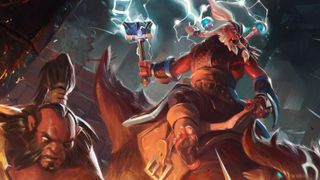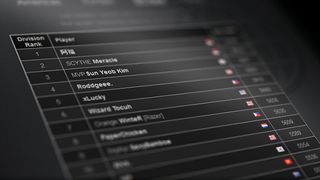Dota 2’s new prime matchmaking continues the slow evolution of the game’s most contentious feature

Thanks to Valve, Dota 2 players that take their rank seriously have a chance to stop seeing blue. They’ve finally added an authentication system to ranked play, which involves registering a phone number to any accounts wishing to queue in the game’s ranked mode (and no, you can’t use numbers from VOIPs such as Skype.)
According to the devs, it’s a response to a longstanding issue of duplicate accounts, or smurfs, used by players to enter matches outside of their assigned skill rank. The rank disparity seems to go both ways: high-skill players smurf in lower matches for entertainment or education, and low-skill players buy higher-level accounts. There’s no single reason for the latter, though accounts in the 6000s and higher can likely play with celebrity pro players. Even players using smurfs in lower accounts can feel accomplished if their higher-level team carries them to victory. Either way, it creates imbalance in the match for the other nine players (provided that they’re not smurfs too).
Already, though, criticism has arisen about the obstacles that the system creates for aspiring professional players.
The phone registration system has been frequently requested of late due to Valve’s implementation of a similar system in Counter-Strike: Global Offensive. Known as “prime matchmaking”, the system certainly hasn’t reduced the number of bitter players in each match, but it’s reduced the number of smurfs that serious players encounter. Dota 2 players are hoping for the same results.
Already, though, criticism has arisen about the obstacles that the system creates for aspiring professional players. Some are concerned that the phone system isolates players in much poorer regions. The game is certainly popular in LAN cafes in regions such as South America, the Philippines and rural Russia. However, there’s also the case that mobile ownership, and even smartphone ownership, is booming in such regions. Since the Dota 2 authentication system only requires a basic telephone, most players will likely avoid this issue.

Even age may not be an issue. In America, at least, the average age of initial smartphone ownership was estimated at about 10 years old, which may not be too far off for other countries as parents rush to keep their kids caught up with their peers. Even then, younger players can borrow a parent’s phone, or use the house phone. In that case, no issues should arise—unless there are multiple Dota 2 players in the house.
For most players, the new system has no real consequences besides a temporary inconvenience. After all, it’s part of the long and complicated history of Dota 2 matchmaking, which is certainly neater than it used to be.
The original DotA actually didn’t have a matchmaking system. Warcraft 3 custom maps such as DotA lacked the perks of default multiplayer, which included regional and ping-based matching. For the most part, players could technically just jump into any public games, but this didn’t necessarily make for a better game. Community leaders stepped in to help alleviate some of this trouble, forming in-house leagues with their own rankings and hierarchies. This was how most DotA players socialized and played.
PC Gamer Newsletter
Sign up to get the best content of the week, and great gaming deals, as picked by the editors.

Then, Dota 2’s beta was released, hoping to improve on many things that were limited in the Warcraft 3 mod. Sometime during this beta, Valve quietly added an unlisted matchmaking rating. Dotabuff, the stat aggregation site, was able to group players into normal, high or very high rankings. Still, the lack of a formal matchmaking system meant that players were free to play with others of any rank, though that wasn’t a major concern in the beta days.
The matchmaking system as we know it today came about in late 2013, after the game came out of beta. It introduced the numerical matchmaking rank, with no upper ceiling but a floor of, of course, zero. Players needed at least 150 games, a fair 85-100 hours for most players, and a series of calibration matches needed to be played for placement. The only major change since then is that the requirement to queue in ranked was changed to a level 13 profile with the summer 2015 Reborn update (and the phone number, of course).
For the most part, it’s remained a pretty acceptable system, and even Overwatch has taken a similar approach with its Competitive Mode matchmaking by using a numerical system plus period calibration. However, that’s generally where Dota 2’s general similarity to other games’ matchmaking ends, and some of the criticism it warrants begins.
Games like LoL or Overwatch are more active in maintaining an up-to-date hierarchy of players.
While there’s been mostly positive feedback over the general ranking system, some have argued that Dota 2 should have a decaying MMR—that is, if a player is absent for a while, their MMR should go down. In many games, such as League of Legends, this system has a floor, meaning that it only applies above a certain rank so that lower-level players don’t need to worry about keeping up. It also means that players coming in after a long hiatus are essentially re-tested in order to prove their rank.
Games like LoL or Overwatch are more active in maintaining an up-to-date hierarchy of players. They also have a seasonal reset and give out vanity rewards for end-of-season success, including a custom real-life jacket for Challenger players in LoL. Players with such high rankings, then, can’t just sit in the lowest Challenger rank and expect a jacket: they need to remain active and competitive. Meanwhile, Dota 2 doesn’t reward high MMR with anything other than pride.
So does Dota 2’s ranked matchmaking have anywhere to go from here? The answer isn’t clear, as ranked MMR is a controversial subject for many players. It’s clear, though, that the community has tried to push Valve to make sure everyone has a good competitive experience, whether in the trench or at the top. Prime matchmaking is a step in that direction.
Most Popular





